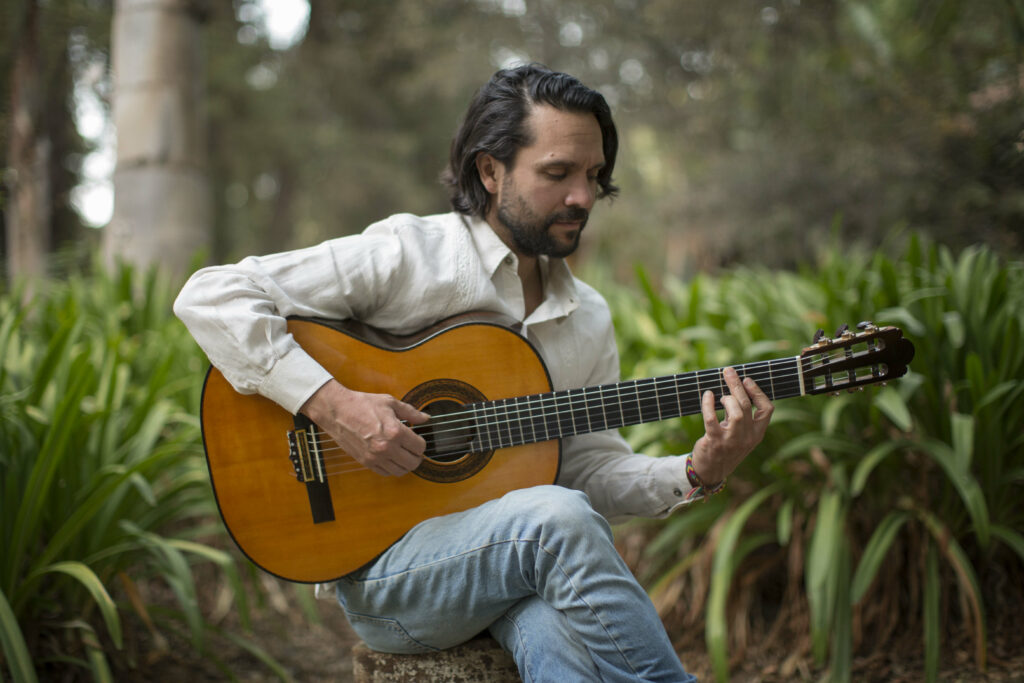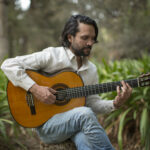Described as ‘a player destined for future glories’ (Classical Guitar Magazine) Morgan Szymanski has been highlighted as ‘One to Watch’ by both Gramophone Magazine and the BBC Music Magazine. A featured artist on the cover of Classical Guitar Magazine, Morgan Szymanski was selected as a finalist for the ‘Outstanding Young Artist Award’ by MIDEM Classique/IAMA.
Born in Mexico City in 1979, Morgan Szymanski started playing the guitar at the age of six. Early studies at the National Music School (Mexico) and the Edinburgh Music School led to a scholarship to study under Carlos Bonell and Gary Ryan at the Royal College of Music (RCM) in London, graduating in 2004 with first class honours. During his studies he won guitar prizes at the RCM as well as being awarded scholarships from the Tillett Trust, Countess of Munster Musical Trust, Leverhulme Trust, Wall Trust, FONCA and a scholarship to study at the Conservatorium van Amsterdam. He went on to become the first solo guitarist to be selected by the Young Classical Artist Trust and was awarded a Junior Fellowship at the RCM, where he completed his Master’s degree with distinction.
A top prize-winner at international competitions, Morgan won first prize at the National Guitar Competition in Mexico. Performances as a soloist and with orchestras have taken him to concert halls and festivals in Argentina, Austria, Belgium, Bermuda, China, Chile, France, Germany, Guatemala, Holland, Ireland, Italy, Luxembourg, Mexico, Macedonia, Portugal, Spain, Switzerland, Scotland, USA, South Africa and Zimbabwe. He is included in the Mexican Foreign Office publication “El Mundo en las Manos” for his contribution as an ambassador of music and Mexican culture overseas.
In recent years Morgan has given recitals at major UK venues and festivals including the Wigmore Hall, Cadogan Hall, Bridgewater Hall, Purcell Room, Queen Elizabeth Hall, King’s Place, The Sage Gateshead, Royal Opera House, and London International Guitar Festival. He has appeared as a soloist with orchestras such as the Academy of St. Martin in the Fields, Royal Philharmonic Orchestra, Hallé, Royal Northern Sinfonia, Filarmónica de la Ciudad de México, Orchestra of the Swan, Southbank Sinfonia, Welsh Chamber Orchestra, Scottish Sinfonia, RTÉ Concert Orchestra, the Cervantes Choir and the Coro de Madrigalistas de Bellas Artes in Mexico’s Palacio de Bellas Artes.
Morgan is a resident artist at Beaminster Festival in Dorset, of which Sir Neville Marriner was patron.
Morgan continues to build his international reputation with performances around the world, most recently including performances at the Shanghai Oriental Arts Centre, Queens Hall (Edinburgh), Luxembourg Philharmonie, National Concert Hall (Dublin), Vienna Konzerthaus, Festival de México and Festival Cervantino. In 2018 he toured South Africa with guitarist James Grace.
Morgan can be heard frequently on BBC Radio 3 and broadcast Alec Roth´s Concerto with the Britten Sinfonia and Mark Padmore live. He recorded Alejandro Basulto´s guitar concerto ´Jig Variations´ with the Shakespeare Sinfonia for Tocatta Classics in a recording celebrating the 75th Anniversary of the Anglo-Mexican Foundation. He also performed Frida Kahlo’s only known song with Lizzie Ball at the Victoria and Albert Museum in London. His recordings on Sarabande Records have been described as “top class in every respect” and as “a jewel” by Gramophone Magazine. Of Szymanski’s “Sketches of Mexico”, Gramaphone Magazine wrote “a gorgeous and original tribute to Szymanski’s homeland, its artists and its music” with Morgan’s playing “of the highest order”. He has recorded the works of Alec Roth for the Signum label with tenor Mark Padmore. His latest recording, “El Arbol de la Vida” was supported by the Mexican Arts Council and includes nine world premieres written especially for him.
Morgan’s devotion to chamber music has led to collaborations with singers Dame Ann Murray and Mark Padmore, guitarists John Williams, Carlos Bonell and Celso Machado, Alison Balsom (trumpet), Harriet Mackenzie and Lizzie Ball (violin), Marcelo Nisinman (bandoneon), Adam Walker and Alejandro Escuer (flute) and the Sacconi, Doric, Amici, Carducci, Cremona, Carlos Chávez and Odeion Quartets.
Numerous composers have dedicated works for Morgan including, Michael Nyman, Alec Roth, Stephen McNeff, Simon Rowland-Jones, Simone Iannarelli, Deborah Pritchard, Paul Coles, Ivan Moseley, Marcela Rodríguez and Julio César Oliva.
He is an alumni of Live Music Now! , the scheme started by Lord Yehudi Menuhin to reach audiences that would otherwise have no access to live music. In 2016 he founded PRISMA, an artistic outreach programme aimed at taking workshops in music and the performing arts to socially disadvantaged and remote areas in Mexico. This project has benefitted over 16,000 Mexican children.
Morgan is much in demand as a teacher and has given masterclasses at top conservatoires worldwide including the Royal College of Music, Royal Welsh College of Music (Cardiff) and Trinity College of Music as well as conservatoires in China and Mexico.
Morgan Szymanski plays on a guitar by the Italian luthier Luciano Lovadina.


 Morgan Szymanski
Morgan Szymanski
